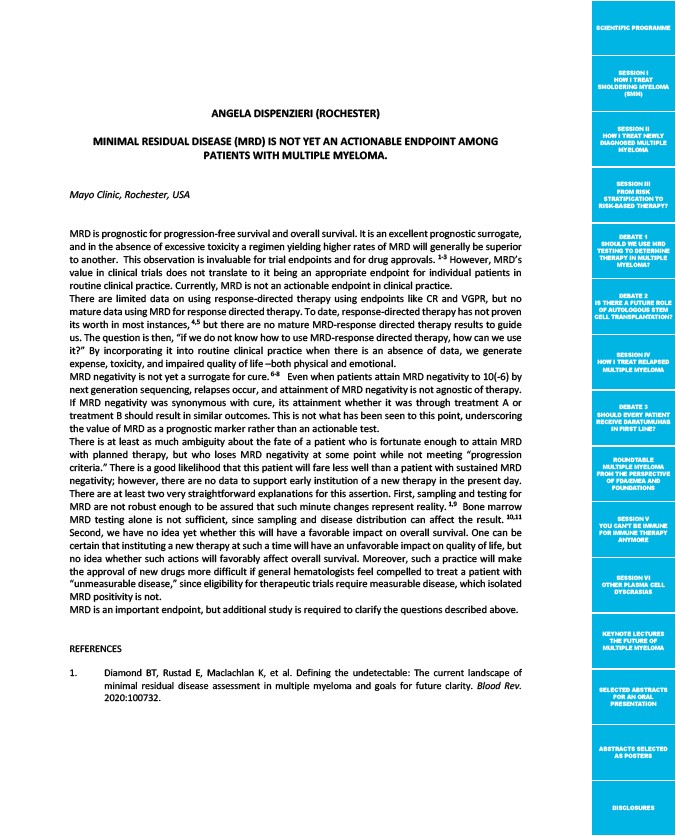
SCIENTIFIC PROGRAMME
SESSION I
HOW I TREAT
SMOLDERING MYELOMA
(SMM)
SESSION II
HOW I TREAT NEWLY
DIAGNOSED MULTIPLE
MYELOMA
SESSION III
FROM RISK
STRATIFICATION TO
RISK-BASED THERAPY?
DEBATE 1
SHOULD WE USE MRD
TESTING TO DETERMINE
THERAPY IN MULTIPLE
MYELOMA?
DEBATE 2
IS THERE A FUTURE ROLE
OF AUTOLOGOUS STEM
CELL TRANSPLANTATION?
SESSION IV
HOW I TREAT RELAPSED
MULTIPLE MYELOMA
DEBATE 3
SHOULD EVERY PATIENT
RECEIVE DARATUMUMAB
IN FIRST LINE?
ROUNDTABLE
MULTIPLE MYELOMA
FROM THE PERSPECTIVE
OF FDA/EMEA AND
FOUNDATIONS
SESSION V
YOU CAN’T BE IMMUNE
FOR IMMUNE THERAPY
ANYMORE
SESSION VI
OTHER PLASMA CELL
DYSCRASIAS
KEYNOTE LECTURES
THE FUTURE OF
MULTIPLE MYELOMA
SELECTED ABSTRACTS
FOR AN ORAL
PRESENTATION
ABSTRACTS SELECTED
AS POSTERS
DISCLOSURES
ANGELA DISPENZIERI (ROCHESTER)
MINIMAL RESIDUAL DISEASE (MRD) IS NOT YET AN ACTIONABLE ENDPOINT AMONG
PATIENTS WITH MULTIPLE MYELOMA.
Mayo Clinic, Rochester, USA
MRD is prognostic for progression-free survival and overall survival. It is an excellent prognostic surrogate,
and in the absence of excessive toxicity a regimen yielding higher rates of MRD will generally be superior
to another. This observation is invaluable for trial endpoints and for drug approvals. 1-3 However, MRD’s
value in clinical trials does not translate to it being an appropriate endpoint for individual patients in
routine clinical practice. Currently, MRD is not an actionable endpoint in clinical practice.
There are limited data on using response-directed therapy using endpoints like CR and VGPR, but no
mature data using MRD for response directed therapy. To date, response-directed therapy has not proven
its worth in most instances, 4,5 but there are no mature MRD-response directed therapy results to guide
us. The question is then, “if we do not know how to use MRD-response directed therapy, how can we use
it?” By incorporating it into routine clinical practice when there is an absence of data, we generate
expense, toxicity, and impaired quality of life –both physical and emotional.
MRD negativity is not yet a surrogate for cure. 6-8 Even when patients attain MRD negativity to 10(-6) by
next generation sequencing, relapses occur, and attainment of MRD negativity is not agnostic of therapy.
If MRD negativity was synonymous with cure, its attainment whether it was through treatment A or
treatment B should result in similar outcomes. This is not what has been seen to this point, underscoring
the value of MRD as a prognostic marker rather than an actionable test.
There is at least as much ambiguity about the fate of a patient who is fortunate enough to attain MRD
with planned therapy, but who loses MRD negativity at some point while not meeting “progression
criteria.” There is a good likelihood that this patient will fare less well than a patient with sustained MRD
negativity; however, there are no data to support early institution of a new therapy in the present day.
There are at least two very straightforward explanations for this assertion. First, sampling and testing for
MRD are not robust enough to be assured that such minute changes represent reality. 1,9 Bone marrow
MRD testing alone is not sufficient, since sampling and disease distribution can affect the result. 10,11
Second, we have no idea yet whether this will have a favorable impact on overall survival. One can be
certain that instituting a new therapy at such a time will have an unfavorable impact on quality of life, but
no idea whether such actions will favorably affect overall survival. Moreover, such a practice will make
the approval of new drugs more difficult if general hematologists feel compelled to treat a patient with
“unmeasurable disease,” since eligibility for therapeutic trials require measurable disease, which isolated
MRD positivity is not.
MRD is an important endpoint, but additional study is required to clarify the questions described above.
REFERENCES
1. Diamond BT, Rustad E, Maclachlan K, et al. Defining the undetectable: The current landscape of
minimal residual disease assessment in multiple myeloma and goals for future clarity. Blood Rev.
2020:100732.